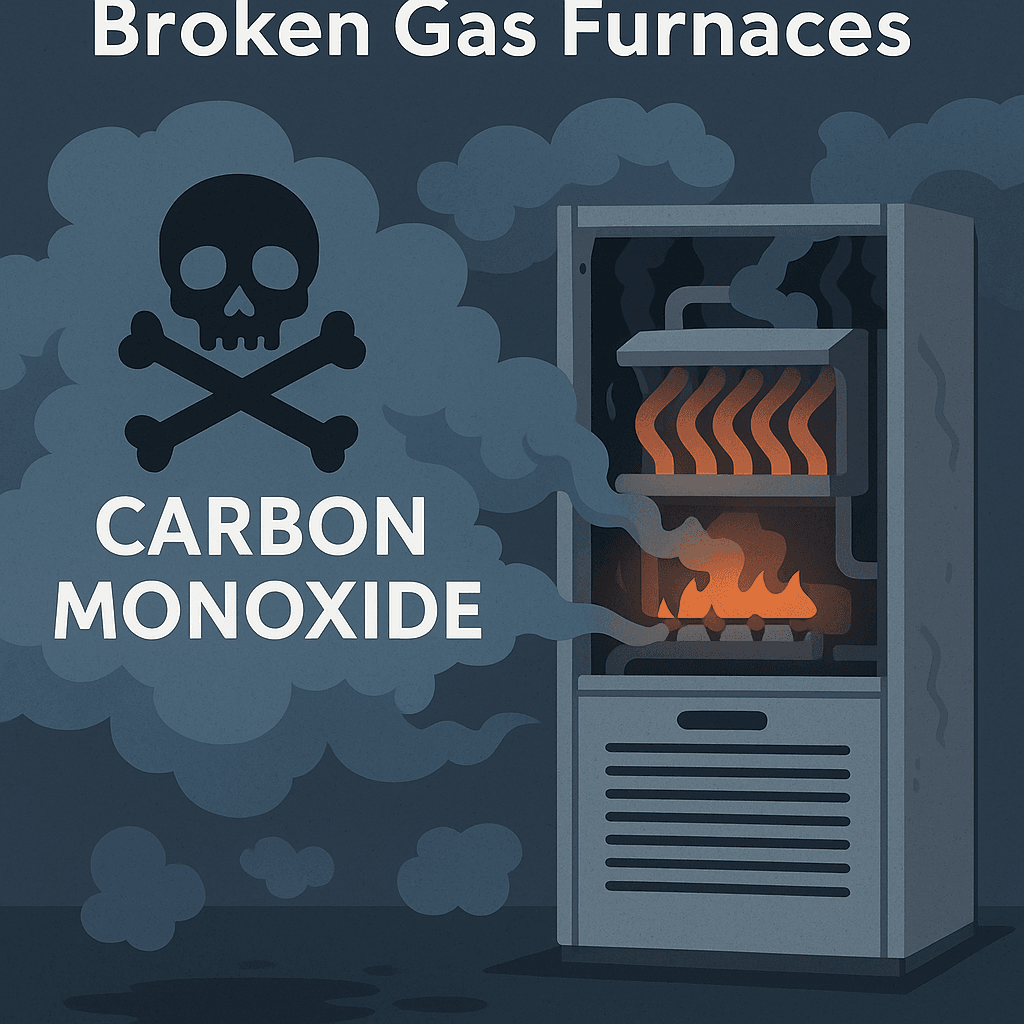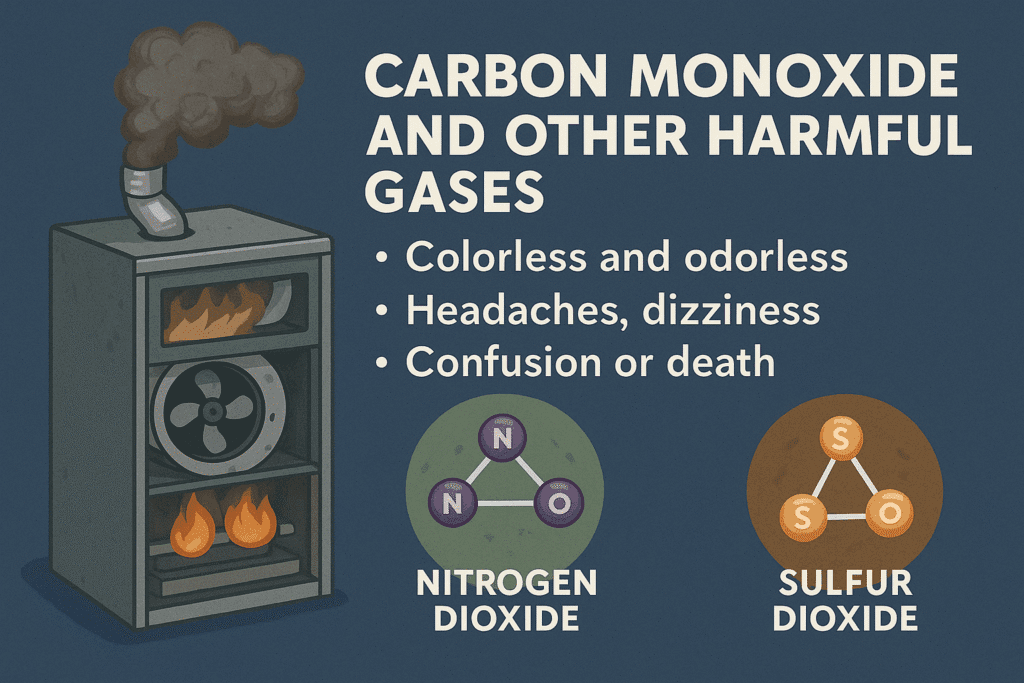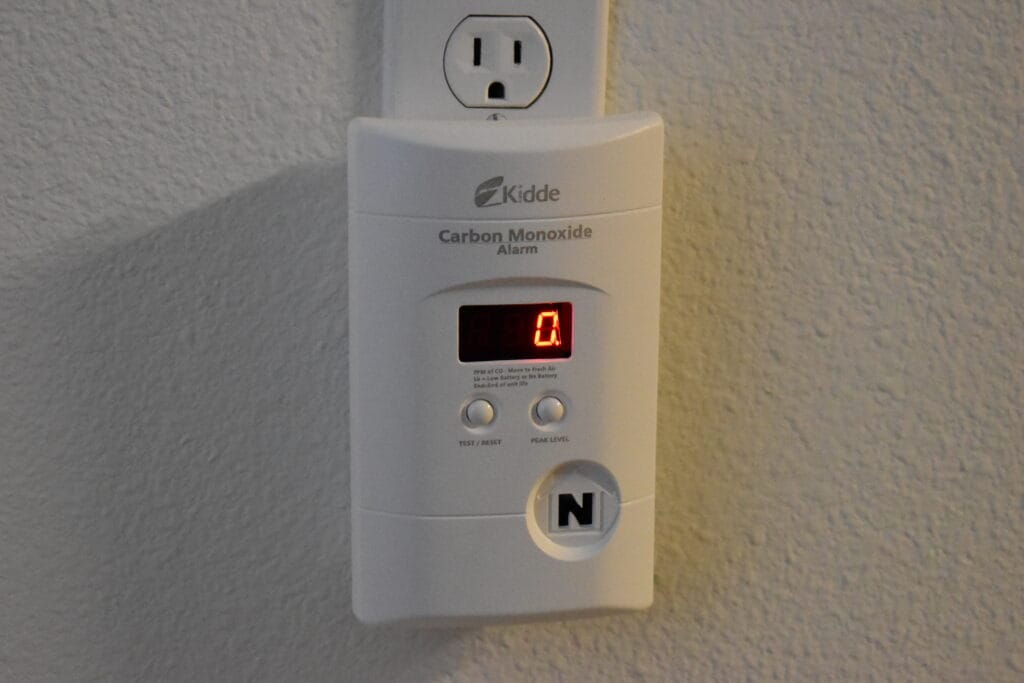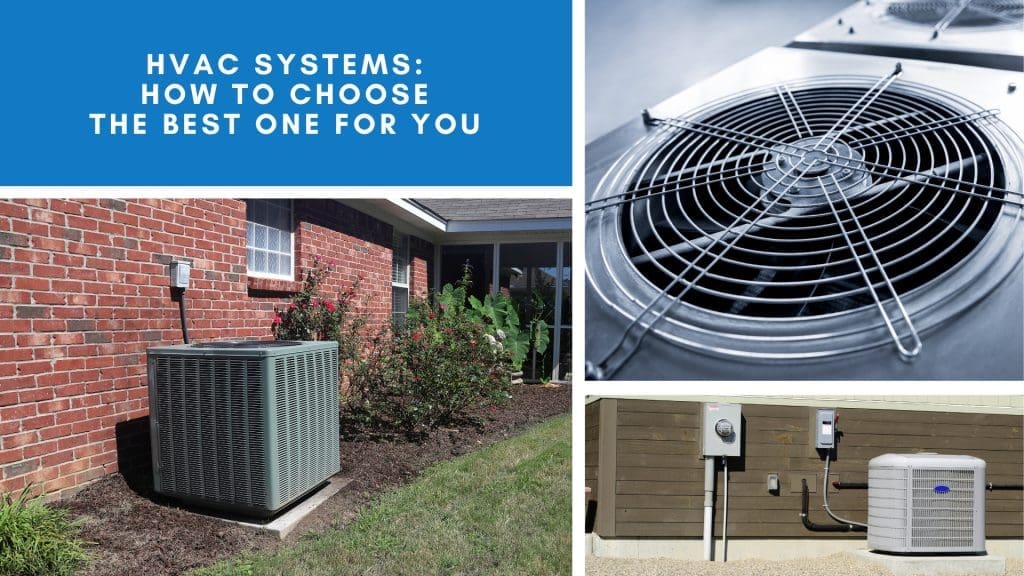En lo que respecta a la comodidad del hogar, el sistema de calefacción juega un papel crucial, especialmente durante los fríos meses de invierno.
¿Pero qué sucede cuando su confiable horno se convierte en una fuente de peligro?
Gas roto hornos Puede emitir gases nocivos, como el monóxido de carbono. Este gas incoloro e inodoro es una amenaza silenciosa que puede ser letal en niveles altos.
No se trata solo de incomodidad. Se trata de tu seguridad y la de tus seres queridos.

Comprender los riesgos asociados a los sistemas de calefacción defectuosos es el primer paso hacia la prevención. Y eso es precisamente lo que exploraremos en esta guía completa.
Desde el reconocimiento de los síntomas de intoxicación por monóxido de carbono hasta las medidas preventivas, lo tenemos cubierto.
Manténgase atento mientras profundizamos en el mundo de los gases nocivos provenientes de los gases rotos. hornosTu seguridad es nuestra prioridad.
Comprensión del monóxido de carbono y otros gases nocivos
Monóxido de carbono El CO es el tema central de nuestro debate sobre los gases nocivos. Es un subproducto de la quema de combustible y puede provenir de sistemas dañados o defectuosos. hornos.

Al inhalar monóxido de carbono, este puede reemplazar el oxígeno en el torrente sanguíneo, lo que causa graves problemas de salud. Esto se debe a que el CO se une a la hemoglobina con mayor eficacia que el oxígeno.
A continuación se presentan algunos datos comunes sobre el monóxido de carbono:
- Es incoloro e inodoro, por lo que es extremadamente difícil detectarlo sin un detector de CO.
- Incluso pequeñas cantidades pueden causar síntomas leves como dolores de cabeza y mareos.
- Una mayor exposición puede provocar confusión, pérdida de conocimiento e incluso la muerte.
Pero el monóxido de carbono no es la única preocupación con los sistemas de gas rotos. hornosOtros gases también pueden suponer riesgos si falla su sistema de calefacción.
Por ejemplo, la combustión incompleta del combustible puede liberar óxidos de nitrógeno. Estos gases pueden irritar los pulmones y agravar los síntomas del asma.
Además, si el combustible contiene azufre, podría liberarse dióxido de azufre. Este gas puede ser perjudicial para la salud respiratoria, especialmente en personas vulnerables.
Comprender estos gases ayuda a reconocer los riesgos potenciales. El conocimiento es un aliado fundamental para mantenerse seguro y mitigar los riesgos.
La amenaza silenciosa del monóxido de carbono
El monóxido de carbono es conocido como un "asesino silencioso". Es invisible y no tiene olor, por lo que es indetectable sin las herramientas adecuadas.
Si se inhala, el CO puede volverse peligroso rápidamente. Sus síntomas suelen ser similares a los de la gripe, como dolor de cabeza y náuseas.
Una exposición más severa puede causar desorientación, pérdida del conocimiento e incluso la muerte. Es crucial reconocer estas señales tempranas.
La detección rápida mediante detectores de CO puede salvar vidas, ya que alertan de fugas de gas con antelación. Todos los hogares con electrodomésticos que queman combustible deberían tenerlos instalados.
Recuerde, cuando se trata de monóxido de carbono, la prevención y la vigilancia son clave.
Otros gases peligrosos de los hornos
Además del monóxido de carbono, otros gases peligrosos pueden escapar de los conductos rotos. hornosLas fugas de gas natural son otra preocupación.
Un horno defectuoso podría tener fugas de gas natural sin quemar. Esto supone un riesgo de incendio o explosión. Su característico olor a huevo podrido puede ayudar a detectarlo.
En algunos casos, hornos Puede liberar dióxido de nitrógeno. Este gas puede irritar el sistema respiratorio, al igual que otros óxidos de nitrógeno.
Además, con sistemas antiguos o con un mantenimiento inadecuado, el dióxido de azufre podría representar un riesgo. Este gas puede causar tos y dificultad para respirar.
Ser consciente de estos peligros potenciales subraya la importancia de realizar visitas regulares. Climatización Mantenimiento. Mantener su hogar seguro va más allá de la comodidad. También implica garantizar que el aire que respira sea limpio y seguro.
Fuentes comunes de monóxido de carbono en los hogares
El monóxido de carbono puede filtrarse en su hogar desde diversas fuentes, a menudo sin que usted se dé cuenta. Es fundamental comprender dónde podrían surgir estos riesgos.
Hornos Las calderas son culpables comunes. Queman combustible para generar calor y, si la combustión no es completa, se puede formar CO.
Los calentadores de agua, especialmente los de gas, también pueden emitir monóxido de carbono. Una ventilación inadecuada o un mal funcionamiento aumentan este riesgo.
Las chimeneas y estufas de leña, por muy encantadoras que sean, también son posibles fuentes de humo. Es fundamental garantizar su correcta ventilación y mantenimiento.
Otros electrodomésticos, menos obvios, podrían sorprenderte. Aquí tienes una lista rápida para tener en cuenta:
- estufas de gas
- generadores portátiles
- Secadoras de ropa a gas
- Parrillas utilizadas en interiores
Los vehículos que se dejan encendidos en garajes adjuntos pueden introducir CO en las viviendas. Es fácil olvidarlo, pero es fundamental mantener siempre el garaje ventilado.
Incluso las cortadoras de césped y las quitanieves en marcha en vacío en espacios cerrados pueden suponer un riesgo. Acciones pequeñas, aparentemente inofensivas, pueden tener graves consecuencias.
Mantenerse informado sobre estas posibles fuentes le permite tomar medidas preventivas. Se trata de garantizar que su entorno sea cómodo y seguro.
Electrodomésticos que pueden emitir CO
Varios electrodomésticos pueden emitir monóxido de carbono, lo que supone un riesgo para su seguridad. Comprender cuáles pueden ayudar en la prevención.
Las estufas de gas son una fuente común de CO, especialmente si no tienen una ventilación adecuada. La pequeña llama de la estufa puede provocar una acumulación inadvertida de CO.
Otro electrodoméstico a considerar es el calentador de agua. Si funciona a gas y tiene poca ventilación, podría liberar monóxido de carbono silenciosamente.
También tenemos generadores portátiles. Esenciales durante los apagones, pero riesgosos si se usan incorrectamente. Usarlos en interiores o demasiado cerca de la casa puede filtrar el CO.
Las chimeneas y estufas de leña añaden ambiente a su hogar, pero también pueden producir CO. Es fundamental asegurarse de que estén ventiladas y que los conductos de humos estén limpios.
Las secadoras de gas, aunque se mencionan con menos frecuencia, pueden emitir CO, especialmente si las rejillas de ventilación están obstruidas. Es fundamental realizar inspecciones periódicas.
Al reconocer estas fuentes potenciales, puede tomar medidas para garantizar que funcionen de manera segura y que su espacio vital se mantenga saludable.
Cómo el CO puede filtrarse en su espacio vital
El monóxido de carbono suele entrar en los espacios habitables por diversas vías discretas. Saber cómo ocurre esto puede ayudarle a proteger su hogar.
Los problemas de ventilación son un factor importante. Las rejillas de ventilación obstruidas o deterioradas pueden permitir que el CO se refluya a las habitaciones. Mantener los conductos despejados es vital.
Las grietas en los intercambiadores de calor son otro punto de entrada potencial. Estas grietas permiten que el CO se mezcle con el aire caliente que se distribuye por toda la casa.
La instalación incorrecta de electrodomésticos aumenta el riesgo, al igual que la negligencia en el mantenimiento regular. Las revisiones profesionales pueden identificar las primeras señales de problemas.
Las puertas y ventanas abiertas cerca de vehículos en funcionamiento pueden invitar al CO. Es un descuido fácil, particularmente en garajes adjuntos.
El retroceso de las chimeneas puede provocar fugas de CO en el interior. Esto ocurre cuando los gases de escape vuelven a entrar en la casa en lugar de salir.
La vigilancia en la revisión y el mantenimiento de los sistemas no solo previene fugas, sino que también garantiza un entorno de vida cómodo y sin riesgos. La concienciación y la acción van de la mano con la seguridad.
Reconociendo los síntomas de intoxicación por monóxido de carbono
La intoxicación por monóxido de carbono puede ser difícil de detectar, ya que los síntomas suelen parecerse a los de enfermedades comunes. Sin embargo, reconocerlos puede salvar vidas.
Los dolores de cabeza y los mareos suelen ser los primeros síntomas. Pueden agravarse rápidamente, así que no los ignore.
Se presentan debilidad o náuseas, con confusión o visión borrosa en casos graves. Si más de una persona experimenta estos síntomas al mismo tiempo, sospeche de CO.
También puede presentarse dolor en el pecho y disnea, especialmente en personas con afecciones cardíacas. La inhalación de CO reduce los niveles de oxígeno en sangre, lo que afecta el corazón.
Incluso las mascotas pueden presentar síntomas como fatiga o desorientación antes que los humanos. Son más vulnerables y pueden reaccionar más rápido al CO.
Con el tiempo, la intoxicación por CO puede causar problemas de salud a largo plazo. Si los síntomas aparecen repentinamente y remiten en el exterior, es hora de investigar.
La respuesta de su cuerpo al monóxido de carbono es una clara señal de alarma. Tome en serio estos síntomas y actúe de inmediato para garantizar su seguridad.
Medidas inmediatas a tomar si se sospecha intoxicación por CO
Si sospecha de intoxicación por monóxido de carbono, es crucial actuar con rapidez. Su respuesta inmediata podría salvar vidas.
Primero, salga rápidamente. El aire fresco puede ayudar a reducir los niveles de CO en el cuerpo. Es el mejor remedio inmediato.
A continuación, llame a los servicios de emergencia. Pueden evaluar la situación y brindar asistencia médica, lo cual es vital si la exposición fue prolongada.
No regrese bajo ninguna circunstancia hasta que se identifique el origen y se declare segura la zona. La seguridad es más importante que las pertenencias.
Mientras espera ayuda, confirme que cualquier persona que presente síntomas reciba evaluación médica. Los efectos del monóxido de carbono pueden persistir, lo que requiere supervisión profesional.
Además, apague los electrodomésticos si es posible sin peligro y abra las ventanas para ventilar el área. Pero priorice su seguridad personal por encima de todo.
En caso de emergencia, prepárese y actúe con decisión. Mantener la calma y seguir estos pasos garantiza el bienestar de todos, desde los familiares hasta las mascotas.
Prevención de la exposición al monóxido de carbono
Prevenir la exposición al monóxido de carbono es fundamental para mantener un entorno doméstico seguro. Esto requiere una combinación de concienciación y medidas proactivas.
Una de las medidas más eficaces es garantizar una ventilación adecuada. Ya sea un horno o una estufa, todos los electrodomésticos necesitan un flujo de aire adecuado para funcionar de forma segura.
La inspección y el mantenimiento periódicos de los aparatos que queman combustible son cruciales. Un aparato bien mantenido tiene menos probabilidades de fallar y tener fugas de monóxido de carbono.
Considere crear una lista de verificación de mantenimiento para llevar un registro de las inspecciones necesarias. Esto ayuda a prevenir la acumulación de monóxido de carbono y garantiza la seguridad.
- Calendario anual Climatización inspecciones.
- Reemplace los filtros del horno periódicamente.
- Revise las tuberías de ventilación para detectar bloqueos o daños.
- Asegúrese de que los electrodomésticos estén correctamente instalados.
También es importante educar a todos en el hogar sobre los peligros del monóxido de carbono. La concientización conduce a acciones informadas y a la prevención.
Los recordatorios visuales, como pegatinas o carteles cerca de posibles fuentes de CO, pueden mantener este tema presente. Sirven como recordatorios sutiles para mantenerse alerta.
Importancia del mantenimiento regular del sistema HVAC
Regular Climatización El mantenimiento es fundamental para la seguridad del aire interior. Un sistema limpio y eficiente implica menos riesgos de fugas de monóxido de carbono.
Dos veces al año, haz que tu Climatización El sistema debe ser inspeccionado por un profesional. Este puede identificar posibles peligros, como grietas en el intercambiador de calor.
Esta medida preventiva garantiza un rendimiento óptimo y una mayor vida útil de su sistema. Además, le brinda tranquilidad.
El mantenimiento incluye la limpieza y la revisión de componentes como filtros y quemadores. La limpieza de los componentes reduce el riesgo de averías y emisiones de gases nocivos.
Un confiable Climatización El sistema requiere un cuidado constante. Considérelo una inversión en seguridad y comodidad para su familia.
Instalación y mantenimiento de detectores de CO
Tener detectores de monóxido de carbono en casa es una medida de seguridad sencilla pero crucial. Estos dispositivos pueden alertarle sobre el aumento de los niveles de CO antes de que se vuelvan peligrosos.
Instale detectores cerca de las zonas de dormir y de los electrodomésticos que queman combustible. Asegúrese de que estén a la altura adecuada para detectar el CO eficazmente, ya que suele estar más abajo en la pared.
Pruebe los detectores mensualmente para confirmar su correcto funcionamiento. Las pilas deben cambiarse al menos una vez al año o cuando el detector indique que la pila está baja.

Los detectores tienen una vida útil de 5 a 7 años. Asegúrese de reemplazarlos según sea necesario para garantizar una protección continua.
Llevar un registro de la fecha de instalación puede ayudarle a saber cuándo es necesario un reemplazo. Esta medida proactiva maximiza su seguridad.
Los detectores de monóxido de carbono son su primera línea de defensa. Con una instalación y un mantenimiento adecuados, ayudan a mantener su entorno sano y seguro.
Servicios profesionales de HVAC: su red de seguridad
Cuando se trata de garantizar la seguridad y eficiencia de su hogar, Climatización En el sistema, los servicios profesionales son indispensables. Los técnicos capacitados poseen la experiencia para identificar y resolver posibles problemas que podrían pasar desapercibidos para el ojo inexperto. Este conocimiento especializado protege contra los gases nocivos que pueden liberar los sistemas defectuosos.
Las inspecciones y reparaciones profesionales le brindan tranquilidad. Le garantizan el correcto funcionamiento de su sistema, minimizando el riesgo de fugas de monóxido de carbono. Las visitas regulares de Climatización Los expertos pueden prolongar la vida útil de sus aparatos de calefacción y refrigeración al mismo tiempo que mejoran calidad del aire interior.
Elegir profesionales para el mantenimiento garantiza un mantenimiento exhaustivo. Revisarán cada componente de su sistema, brindándole una atención integral y previniendo problemas imprevistos. Además, un profesional puede asesorarle para optimizar su sistema de climatización, lo que podría ahorrarle dinero en sus facturas de energía.
Invertir en servicios profesionales de climatización es invertir en seguridad. Nadie quiere arriesgar la salud y el bienestar de su familia, y un mantenimiento experto proporciona una red de seguridad confiable. Con su ayuda, puede estar tranquilo sabiendo que su hogar es un refugio seguro.
Cuándo llamar a un profesional
Saber cuándo llamar a un profesional a veces puede ser complicado, pero ciertas señales son indicadores claros. Escuchar ruidos extraños provenientes del horno o detectar olores extraños son señales de alerta que no deben ignorarse. Estas señales suelen indicar problemas subyacentes que requieren atención inmediata.
Si nota un aumento repentino en las facturas de servicios públicos sin un cambio en el consumo, esto podría indicar una ineficiencia en su sistema. Un profesional puede diagnosticar y solucionar estas ineficiencias, garantizando un funcionamiento óptimo y rentable de su sistema. Los ciclos frecuentes de la caldera o las temperaturas inconsistentes son otras señales que los expertos deben evaluar.
Tener problemas recurrentes, incluso después de intentar solucionarlos por su cuenta, es otro claro indicador. En lugar de luchar en una batalla perdida, solicite la ayuda de un técnico capacitado. Su experiencia y habilidades pueden brindar soluciones duraderas, evitando que pequeños problemas se conviertan en reparaciones mayores.
Calefacción y aire acondicionado LC: su socio de confianza
En Hollywood y en toda el área de Los Ángeles, LC Heating y Aire acondicionado Nos destacamos como un socio confiable en servicios de climatización. Con un firme compromiso con la satisfacción del cliente, priorizamos un servicio confiable y de calidad para cada cliente. Nuestro equipo se dedica a garantizar que su ambiente interior sea seguro y confortable.
Nuestros profesionales aportan una vasta experiencia y conocimiento a su domicilio. Ya sea que se trate de un pequeño fallo o una avería grave, estamos preparados para abordar el problema con precisión y cuidado. No solo solucionamos problemas inmediatos, sino que también ofrecemos asesoramiento para prevenir futuros incidentes.
Lo que nos distingue es nuestro profundo conocimiento de las necesidades y el clima locales. Adaptamos nuestros servicios a las necesidades específicas de los hogares del sur de California, garantizando un rendimiento óptimo durante todo el año. Elija LC Heating and Aire acondicionado Para su tranquilidad, saber que el sistema HVAC de su hogar está en manos expertas.
Conclusión: Mantenerse seguro y abrigado
Mantener un ambiente hogareño seguro y cálido se reduce a la diligencia y la conciencia. Regular mantenimiento Y la intervención profesional oportuna son clave para prevenir fugas de gases nocivos como el monóxido de carbono. Estas medidas protegen no solo su sistema de calefacción, sino también la salud de todos los miembros de su hogar.
Invertir en un mantenimiento adecuado de su sistema de climatización (HVAC) le brinda tranquilidad, especialmente durante los meses más fríos, cuando aumenta la demanda de calefacción. Recuerde que la seguridad de sus seres queridos es invaluable. Al mantenerse informado y proactivo, garantiza un espacio seguro, cálido y confortable durante todo el año. Priorice la seguridad y la calidez llegará sola.
Preguntas frecuentes sobre el monóxido de carbono y los hornos
Cuando se trata del monóxido de carbono y los hornos, suelen surgir preguntas. Abordemos algunas comunes para asegurarnos de que esté bien informado.
¿Qué electrodomésticos emiten monóxido de carbono?
El monóxido de carbono puede ser emitido por cualquier aparato que queme combustible. Esto incluye estufas de gas, hornos, calefactores y chimeneas. Incluso un coche en marcha en un garaje adjunto puede suponer un riesgo. Preste atención a los electrodomésticos de su hogar y asegúrese de que reciban el mantenimiento adecuado.
¿Cómo sé si mi horno tiene una fuga de monóxido de carbono?
El monóxido de carbono es incoloro e inodoro, lo que dificulta su detección sin el equipo adecuado. Una de las mejores maneras de saber si su horno tiene una fuga de CO es usar un detector de monóxido de carbono. Las inspecciones periódicas realizadas por un profesional también pueden ayudar a identificar posibles fugas.
¿Pueden los acondicionadores de aire producir monóxido de carbono?
No, los aires acondicionados no producen monóxido de carbono. Sin embargo, un sistema de climatización (HVAC) defectuoso puede afectar... calidad del airePor lo tanto, el mantenimiento regular es crucial para garantizar un rendimiento y una seguridad óptimos.
¿Qué debo hacer si se activa mi detector de monóxido de carbono?
Si su detector de monóxido de carbono se activa, tómelo en serio. Evacue la casa inmediatamente y llame a los servicios de emergencia. No vuelva a entrar hasta que los profesionales confirmen que es seguro. Es fundamental tener un plan y asegurarse de que todos los miembros del hogar lo conozcan.
Lista de referencia rápida
- Realice el mantenimiento e inspección periódico de los aparatos de calefacción.
- Instalar detectores de monóxido de carbono en cada piso.
- Asegúrese de que todos los electrodomésticos tengan una ventilación adecuada.
- Responda inmediatamente a las alertas del detector y evacue si es necesario.
Mantenerse informado y preparado puede reducir significativamente el riesgo de exposición al monóxido de carbono en su hogar. Su seguridad vale cada precaución que tome.


